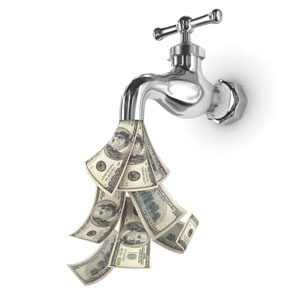
Whether it’s grandparents aging out of their traditional homes or kids moving back home (and sorry, Junior, your parents already turned your old bedroom into something else), we’re seeing an interesting trend taking shape – the building of small but separate homes in the backyard.
They’re known as “Accessory Dwelling Units” (ADUs) but they’re more commonly called terms like “granny flats” or “in-law units.” While these property units aren’t inexpensive, Zillow has found that they can enable the homeowner to price the property 60% higher than those without them. After all, if you are able to have more generations comfortably enjoying the home at once, there’s greater value to be seen from it.
For contractors, the presence of an ADU provides even more potential area of a dwelling to enhance. And in the case of kitchen and bathroom refinishing projects, it’s a small investment for a larger return. Homeowners will need to confirm that zoning ordinances aren’t restrictive of building such units on a property. However, there may be some wiggle room depending on the size and structure of the unit in relation to the main property.
Regulatory concerns aside, this trend may have some staying power as a smart long-term investment that allows the family to live together in proximity to each other without having everyone literally live under the same roof.
If you’ve been looking at bathroom and kitchen refinishing opportunities occurring strictly in a standard family home, it’s time to literally think outside of that box. Whether it’s grandparents aging out of their traditional homes or kids moving back home (and sorry, Junior, your parents already turned your old bedroom into something else), we’re seeing […]

Many of us aren’t natural-born bookkeepers, but as business owners, having a basic understanding of the concept of cash flow is vital. When you can more properly manage how cash flows in and out of the business, you can not only get a firmer grasp on your financial day-to-day but you can prepare for the expenses to come – even those that are a little more unexpected.
Here are 3 big cash flow challenges we frequently hear about that can be met and solved with adjustments that are easier than you may expect:
“I’ve Got Bills That Need To Be Paid.”
Yes. But do those bills need to be paid as soon as you receive an invoice? Probably not. So why give yourself undue stress by paying it early? This doesn’t mean putting it off – don’t do that. But if the bill is due in 30 days, pay it electronically at that time. If an expense happens to come up in the interim, you’ve allowed a buffer for that too.
“I’m Always Waiting On A Check Or Two I Shouldn’t Have To.”
True. You shouldn’t have to wait for checks. But be honest about your part – are you consistent about when you send invoices out in that it’s always the same time each week or month? Or is it something you get to later on after doing the actual work? When invoicing isn’t a part of your regular schedule, you’re not making it important enough and inadvertently hurting your cash flow in the process. Schedule it with no exceptions.
In addition, think about what kind of incentive you could offer to clients that pay early. Might they get a small discount on the overall bill if they pay well before the due date? This gives you more funds in hand earlier on so you can be less worried about getting everything in right at the end of the month.
“Buying This New Equipment Will Hamper My Funds For A While.”
Do you have to necessarily buy it? What long-term financing options are available? You may be able to lease the equipment so that you can utilize it today without crunching your funds so much more here and now due to an outright purchase. Even if you wind up spending more on the item over the long run, what you may save in the present for your business may allow you to invest in other necessary items as well. A full purchase may not afford you that flexibility.
“Cash flow? I’m not some CPA who can predict this stuff.” Many of us aren’t natural-born bookkeepers, but as business owners, having a basic understanding of the concept of cash flow is vital. When you can more properly manage how cash flows in and out of the business, you can not only get a firmer […]
For over 100 years, baseball was a game defined by what seemed like simple things: Wins and losses. Obviously the more talented team you had, the more you’d be in a position to win a lot more games on your quest to be a world champion. But in about the last decade, as teams gained more access to data on players that they could drill down on, General Managers realized that they could have greater insight on each player’s value in their contribution to the team beyond the simple statistics that everybody knew.
What does this have to do with the refinishing business? This: On paper, you have a certain of jobs you’ve bid for and been successful with as well as some jobs that didn’t come through. Those are your wins and losses. But do you know exactly why your record is where it is and what you could do improve upon it?
Much like baseball management, refinishers have to go beyond the first numbers they see to ask: Why did I win those jobs? Why did I lose those jobs? What did I do to encourage a successful referral? Was that referral always an ideal customer and if not, why not – was there something I could’ve said or done to guide the referring customer?
Suddenly, you’re getting a little more analytical about your business, aren’t you? It’s easy to simplify the answers to say, “One person was cheaper so I lost the job due to that.” But was it really just about price? Or was there something about your process that wasn’t communicated clearly, which in turn made the prospect uncomfortable to choose you over someone who spelled out every detail?
Where To Start
Think about the last 10 jobs you bid on and remember which ones you got and which ones you didn’t. That gives you a “win ratio” that’s going to be ever-changing but one that will help give you something to start with as a baseline and improve upon over time. So if you bid for 10 jobs and won 6 of them, you’re batting at a 60% clip. You may also go by a certain number of jobs in a month or a quarter if that’s easier to track.
This is where the baseball General Manager might start, by seeing some averages and win-loss records on paper. It’s a starting point. Now we have to find out why those averages and records are the way they are.
Know Why They Chose You – Or Didn’t
A baseball General Manager has a scouting report to help him get a better sense of the averages and records of each player. The more he knows about the details, the better he can make adjustments.
In your world, this means it’s time to understand where our customer is coming from in making their decision.
Many of us are just so happy that they decided to go with us that we never aim to understand why. What does it matter, right? We got the business! But we don’t always know why we got the business.
Again, price may be something that’s easy for them to say but there might be more to it than that. Ask them or, at the very least, provide a feedback form at the end of the job that helps you gain some greater insight on why they selected you, what they thought of the process, what they might recommend you improve upon and how likely they would be to refer you to others. This feedback is tremendous and it’s important for you to get it before you walk out the door at the completion of the job. Why? The details are fresh in their mind so they can elaborate more clearly and it gives you a sense of great professionalism in being seen as someone who is serious about providing the most positive experience possible.
Similarly, when we’re told we didn’t get the business, we don’t aim to understand that very much either. We just want to move on as quickly as possible without dwelling on our negative qualities because it feels like adding insult to injury. But just as we want to get feedback no later than when the job is complete when we win, we want to get feedback quickly when we’re told we didn’t win because it’s recent and the detail should be at its clearest. At first, our customer may feel uncomfortable in telling us why they didn’t choose us, but give them a sense that it’s OK to express the reasons as we’re just trying to understand what to improve upon. Losing is always hard but gaining intelligence on how to improve our chances of a win next time takes a little bit of the sting away.
Don’t forget to make sure that when you’ve been referred to understand from the new customer who originally did the referring and why they referred you.
Align Your Process and Message
Once the baseball General Manager has his data, he has to see how it all plays out on the field. If a player has a low average and we learn he’s been striking out quite a bit, there may need to be some adjustments to their swing or batting stance. Obviously a baseball player’s challenges won’t fix themselves without knowing where to look so this information is key.
In the same sense, now that we have more information on why people gave us the business, went somewhere else or referred us business, of that what can we incorporate into what we say and do for a prospective customer so that we’re saying the kinds of things that are important to them? When we have the opportunity to make some adjustments and see how those adjustments play out in the field by continuing to measure results, we can become better and better at what we deliver for people. From our introductory impressions to after the job is done.
Give this strategy a try and stick with tracking your results to see where you can hone your “game.” Here’s hoping you’re headed for a season to remember.
For over 100 years, baseball was a game defined by what seemed like simple things: Wins and losses. Obviously the more talented team you had, the more you’d be in a position to win a lot more games on your quest to be a world champion. But in about the last decade, as teams gained […]
There’s a recorded call on your business phone line from someone claiming to be a Google representative. They’d like you to contact them about your local business listing because, after all, don’t you want to be found more easily online? They can fix some things up for you in no time and you’ll find yourself ranking higher and higher.
Except it’s all a lie. They’re not from Google.
They’re from an agency making illegal calls to dupe small business owners into buying their services by pretending to be Google. Once you give up sensitive information to these sources such as credit card info or passwords, there’s no telling what kind of havoc they might create. And fixing that is the last thing a small business owner needs on their plate.
It can be hard to spot the difference in such calls, so don’t let your business be the next victim. Simply put: Google does not robocall. An actual call from the real Google will feature a live person – not a recording. Similarly, an email from Google will end in “@google.com.”
Truth be told, the Google robocalling scam isn’t the only one out there but one of the more popular ones (we’ve heard everything from the IRS to Microsoft). Most of the time, the common thread all of these suspicious calls have is that there are not “live” human beings making the call.
If you receive a robocall, hang up immediately and do not press any buttons to go into a menu. If the problem persists, you can block the number on your phone as well as visit www.donotcall.gov to register your phone number with the National Do Not Call Registry.
There’s a recorded call on your business phone line from someone claiming to be a Google representative. They’d like you to contact them about your local business listing because, after all, don’t you want to be found more easily online? They can fix some things up for you in no time and you’ll find yourself […]
Before you know it, we’re going to arrive at the month of April – which people in some of our colder climates can’t wait for! However, for homeowners considering putting their homes on the market during the peak time of year in spring and summer, it’s literally time to get their house in order. This includes starting cost-effective kitchen countertop and bathtub resurfacing projects that can yield big dividends in resale value.
For refinishers, the opportunity to tailor messaging to this audience of sellers is a big one in 2016 in particular. Why? We see increasing evidence from sources like realtor.com that this year will be primarily a seller’s market. Home prices should continue to rise while inventory stays at a fairly low level nationwide. Typically, that combination results in the kind of bidding war that benefits the seller.
In an effort to avoid these types of bidding wars, don’t be surprised if some home buyers try to do their home shopping earlier than expected. A motivated seller could capitalize on this by getting certain projects that are not major renovations out of the way now, providing them with improvements in the kitchen and/or bathroom. We know that both of these rooms can often be the most critical to a home’s value.
While the average home price nationwide is expected to rise 3% compared to last year’s pricing, some markets could be significantly higher such as 5% or even as much as 10%. When a home can increase by up to 10% depending on the market, the financial investment of countertop or bathtub refinishing appears incredibly reasonable.
What if a seller takes a “wait-and-see” attitude to what the housing market will bring in terms of ensuring they get the price they want for the home – especially since we haven’t seen a full recovery? A countertop or bathtub refinishing project still makes a great deal of sense here. The turnaround is far quicker than an extensive remodel and less expensive, enabling the homeowner to make a small improvement now that can pay off down the road once they ultimately decide to put the home on the market.
A lot of trends can shift between now and the end of the year, but by all indications, the seller should have plenty of leverage in early 2016. Approach this part of your audience now with messaging that stresses the urgency of preparing the home for the prime buying season right around the corner with refinishing projects that create a beautiful result.
Before you know it, we’re going to arrive at the month of April – which people in some of our colder climates can’t wait for! However, for homeowners considering putting their homes on the market during the peak time of year in spring and summer, it’s literally time to get their house in order. This […]

If you’re like most people in the trade, you really don’t. But that’s a great opportunity to take a look at having more of a process for getting motivated customers to share a good word on your behalf to others.
First, no matter how much they enjoyed your work, you can’t expect happy customers to keep you in mind if you don’t do anything to consistently remind them about your business.
It’s not that they don’t care. The reality is with everything they have going on in their lives, out of sight (after a completed job) is out of mind and they’re not going to keep their eyes open for you as if they were paid sales representatives. This means any approach you have has to have some kind of frequency to it, reminding those customers of the quality work you provided to them and continue to provide to others.
Who are we targeting for a referral exactly?
Anyone you’ve ever done a job for? That’s a possibility. But perhaps you haven’t kept track of every name, phone number, email, etc. over the last several years. If that’s the case, don’t panic. Let’s start by thinking about your very best customers, not every customer you’ve ever had. These are the folks who loved your work and would be happy to sing your praises when prompted. They seem to respond fairly quickly to any communication of yours, such as email. They may even “Like” things you post on social media. It’s a circle of allies who are in your corner. So when you approach them for a referral, at a minimum they should be very open to the idea. Start with this inner circle as your referral base – however, you don’t have to stop expanding it just because you don’t have complete contact info from everyone. Which brings us to our next step.
Next, let’s connect to our customers past and present on LinkedIn.
Now we want to expand the circle further by ensuring both our best customers and every customer we’ve done work for is a Connection on LinkedIn – that’s right, even if they’re in our database with complete information. Emails change. Phone numbers change. But people who are LinkedIn generally stay on LinkedIn as they change jobs, locations and more. Don’t let a connection fade because you have outdated information and didn’t connect to that person on LinkedIn. You may not have all of their contact info, but you surely can remember their names or do a search on LinkedIn to track them down.
How are you making it easy for them to give your info to others?
Imagine this likely scenario just as a referral is about to be given:
Prospect: “Your kitchen countertop looks beautiful, Julie.”
Customer: “Thanks! I just had them refinished.”
Prospect: “Do you mind if I get your contractor’s info? We’re interested in doing something similar in our kitchen.”
Customer: “Sure! I have it around here somewhere. I think he gave me a card. I hope I didn’t throw it away by accident while I was cleaning. Oh well. I’ll track it down and send it to you later.”
Now the door is left open for Julie to forget to send her friend your information later on. Her intentions are good. But she’s got a thousand different things to remember today alone – what’s going to happen when a few days pass? Yes, you gave her your business card. Still, people will rarely have your card handy at the exact opportunity of referral.
On the other hand, if you’ve sent email communication recently, guess what? Julie can now say, “Oh! I actually just got an email from him. Let me look on my phone. I’ll forward you the info.” The one thing people always have with them is their phone. They simply can’t disconnect from it (to a fault in many cases!). Use that to your advantage by getting into their email’s in box regularly. Once a month is reasonable. Once a year is too long.
What is it that they’re receiving from you? It has to be more than “do you know anyone” requests alone.
That’s not only pestering but it’s boring. At a minimum, your email communication should include some added value for their benefit. They were looking to make an improvement to their kitchen or bathroom – what else might they like to know about remodeling that area, particularly on a budget? Do you have a photo or case study of a recent job you’re proud of? Could a friend of yours in a similar trade provide a valuable design idea? It’s OK to include a request for referral as part of what you’re emailing. Just don’t make it the entire story. They’ll tune out quickly.
What if they don’t have a name for referral in mind right then?
Don’t say, “Thanks anyway” and give up. Proceed to the next step: Ask them for a testimonial quote that you can put on your website, LinkedIn, email signature, company materials and any place a prospect has the potential to make a decision on a next step. Even the back of your business card!
This testimonial can be emailed to you or you can ask over the phone. The commitment is a very low 3-5 sentences and if they want to provide more than that, that’s terrific. Start with your best customers of the past and present.
Then make it your goal going forward that every single customer you have – whether they ultimately provide you a referral or not – is going to provide you with a testimonial of your work. Think about how many of these you could accumulate in a year’s time. It’s the next best thing to actually sending your business because it’s proof of your work in front of a prospective customer from a 3rd party.
How will you reward / thank them?
This doesn’t have to mean some extraordinary sum of money. Some people are touched by receiving a hand-written thank you note with a small Starbucks gift card. The point isn’t so much what the reward is, believe it or not. The point is that you’re automatically giving someone who referred you business a response that shows gratitude in a caring way. That’s what makes it more likely that they’ll refer again. Build the incentive/reward portion into your process for what you do upon receiving referrals – and don’t let a few months pass before you act!
By making these “tune-ups” to your referral process, you’ll be running a tighter new business machine that helps your best customers help you.
Question: Do you have a real process for getting a referral from current and former customers? If you’re like most people in the trade, you really don’t. But that’s a great opportunity to take a look at having more of a process for getting motivated customers to share a good word on your behalf to […]

Keeping up with payroll tax payments can be a headache for any small business, especially if you’ve ever fallen behind and made a late payment. Before long, the extra penalties and interest charges from the IRS can multiply, making it more difficult to stay on top of payments. The collateral effect? Suddenly, that important piece of equipment you planned on buying has to be delayed for a little while as you catch up on tax payments. To make matters worse, the IRS has never been the most proactive government agency, at times waiting until small business owners are facing the most dire financial circumstances to offer assistance.
Fortunately, the IRS’ new Early Interaction Initiative may offer a breath of fresh air for many small businesses concerned with payroll tax challenges. The effort aims to identify businesses that are falling behind on tax payments much earlier in the process. Through automatic alerts, the IRS can be notified before an employment tax return is filed and get involved to offer advice that may help the business get back on track for making payments. This could come in the form of a letter, automated phone message or possibly a visit from an IRS officer.
While the idea of a visit from the IRS may not be the most appealing thought right now, neither is the scenario of mounting tax liabilities. Some early interaction now through the Early Interaction Initiative may provide a plan that’s manageable and a solution that’s easier to envision. That way, you can focus on investing funds in the things that move your business forward – instead of constantly playing catch up.
It’s not every day that we get to mention something positive that the IRS is rolling out on behalf of small businesses, but its newest program may just qualify. Keeping up with payroll tax payments can be a headache for any small business, especially if you’ve ever fallen behind and made a late payment. Before […]

Yes, home sales have gradually increased and this year’s final total should be slightly higher than last year’s. So will this move by the Fed reverse the trend and cause home buying to tighten up?
The good news: If home buying slows, it won’t have nearly as much to do with mortgage rates as people might think.
First, the increase was only a quarter of a point, which will make the cost of a mortgage only marginally more expensive each month. So in many cases, that increase alone won’t prevent any serious buyer from rethinking their plans.
Secondly, even though a great many consumers have been in saving mode in recent months vs. spending, some economic experts see a shift coming in early 2016 with home sales picking up significantly. According to Fannie Mae’s Chief Economist Doug Duncan:
“Housing demand is looking up as we head into next year. The rebound in purchase applications suggests that sales will gain momentum in the first quarter after retreating slightly in the current quarter. For all of 2016, total home sales are projected to rise 3.9 percent. We believe that further easing of mortgage lending standards will combine with a positive household formation outlook to help the housing sector expand.”
Based on what we continue to see and hear, chances are good that this interest rate increase won’t be the only one coming from the Fed. There could be as many as three more increases on the way in 2016. However, as long as these increases are gradual and small, the impact on housing shouldn’t be drastic.
That said, what we’ll want to keep a close eye on are two key factors: Job growth and overall incomes increasing across the country.
These factors need to keep pace with home prices possibly increasing as much as 5%. A percentage of potential deals may not go through as a result if the buyer’s income can’t rise in proportion to this pricing. While not expected to be a widespread challenge, it’s a scenario that has to be considered as we move through 2016. Yet if jobs and incomes move upward in a consistent fashion, the impact from small interest rate increases, even multiple ones, could be minimal.
What this means for new home projects
Certainly smaller projects in the home such as a bathtub or countertop refinishing shouldn’t lose any traction in the first quarter of 2016. With homeowners saving money in recent months, the timing may be very good for kicking the new year off with these affordable projects that could yield big returns down the road. If home buying isn’t expected to slow down and even increases despite a number of interest rate hikes, a homeowner with an eye on selling once the snow melts in the Spring might be wise to have a conversation about refinishing, reglazing and resurfacing now to get that project underway to prepare for an ideal showing.
For the first time since 2006, the Federal Reserve announced a hike in its short-term interest rates. Almost immediately, speculation took off across the media with questions about what this increase might mean for a variety of sections of the economy – the housing market being one of the most prominent suspects. Yes, home sales […]

However, let’s be honest – will a gift like that automatically trigger someone to call you up to thank you? We’d like to say the answer is yes but the safe bet is that they’ll simply be appreciative of it. Not that it’s a bad move, but you can do more. So try a few tactics like these:
#1: Make It Personal
Nothing, absolutely nothing, may go farther with former customers than a personal note mailed to them. Hand-written is a nice touch but even if it’s an email, include the specific aspects of the job that show that customer how much you remember them and how much their business mattered. You could leave it at that and include a business card, but we’d like to see you take it one step beyond this, which is where #2 comes in.
#2: Include A Special Holiday Referral Gift And Offer
A personal note by itself is nice but doesn’t give the recipient a next step action. A special offer by itself can be nice but even more effective when personalized. Combine the best of both by including a code or separate card in your personal note that offers a gift for the former customer referring you and a discount to the new customer. We recommend offering it for a limited time, thus the holiday theme and timeframe. This can be done as a physical piece that’s mailed or included in an email message – just remember to do your part upfront on the personal side so they’re feeling as though they’re receiving something just for them, which they should be.
#3 Don’t Forget Your Database Cleaning Opportunity!
Make sure your note includes this phrase somewhere toward the end:
“One more thing, John – I have you at the following email and phone number as I’d like to keep in touch. Is that still correct?”
By adding this little, innocent enough question, you’re setting the table to have a follow-up conversation via phone or email to ensure your email database of customers and colleagues is fresh. It doesn’t mean that you’ll bombard them with emails every week after that asking if they know anybody to refer your way (really, don’t do that). But it does mean that you could easily and comfortably send them some email correspondence through offers or an eNewsletter once a month, which is not a frequency that offends many people at all. If you’ve done a good job for them and continue to showcase your work for others, you’re reminding them of your reliability on a consistent basis 12 times a year. The holidays could be the perfect time to ensure their contact information is up to date so you can roll into the new year knowing you’re sending messages out that are going to be received.
Give these tactics a try now. With any luck, you’ll discover the holidays are a gift that keeps on giving referrals all year round.
Word-of-mouth referral is powerful as we can attest to – the question is how do we make it work for us more often? Frankly, we have to use times of year for the opportunities that present themselves, like the holidays, when your former customers are expecting to hear from old friends and colleagues. 9 out […]

What else doesn’t have to be done between 9am-5pm? Networking. It’s great to get your name out there by attending community events, but think about the time you’re taking up in your day if you attend a networking lunch. You have to travel to the event, attend it for at least an hour and return. That’s probably 2 hours out of your day at a minimum. What would having those 2 hours back in your day mean? More time actually working. Prospecting is not necessarily something that has to be done in the daylight. Consider an evening event after 5pm, which brings a different kind of crowd that’s a bit more casual that you might enjoy interacting with. It’s OK to make an exception now and then if you believe a lunch is worth attending, but understand what you may be sacrificing in the amount of time because as the adage goes, time really is worth money.
Let’s take one more example of something that doesn’t have to be done when the sun is shining – marketing. That’s right. You’re researching where to buy your business cards from? Don’t do it during the day. You need a hand on getting up a simple website or refreshing an existing one? No reason for you to be heading online at 2pm to investigate your options. Even if you are sending out a monthly eNewsletter through a service like Constant Contact or MailChimp, the actual work on that can be done later than 5pm.
What else can you think of that could be pushed until after 5pm? Conversely, besides the work on site at the customer location, what tasks in your day absolutely can’t be moved out of the 9am – 5pm timeframe? Fill your day with these essentials that can’t be pushed under any circumstances and move out everything else where business won’t be hurt if it gets done later in the evening.
This is what working smarter is all about for your business. Give it a try for a while. You’ll hopefully be amazed by your newly found efficiency.
Why does it seem like you never have enough time in the day to get the things done that you want? It could be that you’re spending precious minutes on tasks that don’t absolutely require you to work on them in “normal” business hours. One of the biggest culprits we see for sucking up time […]



